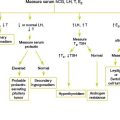Chapter 11 CONSTIPATION
General Discussion
In children younger than one year of age, the possibility of Hirschsprung disease must be considered. Approximately 40% of children with functional constipation develop symptoms during the first year of life. Functional constipation is the diagnosis in more than 95% of cases of constipation in children older than 1 year. The passage of infrequent, large-caliber stools is highly suggestive of functional constipation. The Rome III criteria for functional constipation are outlined below. Note that the criteria are different depending whether the child is older or younger than 4 years of age (Table 11-1).
| For infants up to 4 years of age, at least 2 of the following criteria must be present for 1 month:
1. Two or fewer defecations per week 2. At least 1 episode per week of incontinence after the acquisition of toileting skills 3. History of excessive stool retention 4. History of painful or hard bowel movements 5. Presence of a large fecal mass in the rectum 6. History of large-diameter stools that may obstruct the toilet |
1. Two or fewer defecations in the toilet per week
2. At least 1 episode of fecal incontinence per week
3. History of retentive posturing or excessive volitional stool retention
4. History of painful or hard bowel movements
5. Presence of a large fecal mass in the rectum
6. History of large diameter stools that may obstruct the toilet
 Passage of meconium more than 48 hours after delivery, small-caliber stools, failure to thrive, fever, bilious vomiting, bloody diarrhea, tight anal sphincter, and empty rectum with palpable abdominal fecal mass (all are suggestive of Hirschsprung disease)
Passage of meconium more than 48 hours after delivery, small-caliber stools, failure to thrive, fever, bilious vomiting, bloody diarrhea, tight anal sphincter, and empty rectum with palpable abdominal fecal mass (all are suggestive of Hirschsprung disease)
 Failure to thrive, fever, rash, and recurrent pneumonia (suggestive of cystic fibrosis)
Failure to thrive, fever, rash, and recurrent pneumonia (suggestive of cystic fibrosis)
 Absent cremasteric reflex; absence of anal wink; a decrease in lower extremity reflexes or muscular tone; or the presence of a pilonidal dimple, pigment changes, or hair tuft in the sacrococcygeal area (suggestive of spinal cord abnormalities)
Absent cremasteric reflex; absence of anal wink; a decrease in lower extremity reflexes or muscular tone; or the presence of a pilonidal dimple, pigment changes, or hair tuft in the sacrococcygeal area (suggestive of spinal cord abnormalities)
 Abnormal anal position or appearance on physical examination
Abnormal anal position or appearance on physical examination
Key Historical Features
Key Physical Findings
 Abdominal examination to evaluate for a fecal mass in the suprapubic area and for distention or organomegaly
Abdominal examination to evaluate for a fecal mass in the suprapubic area and for distention or organomegaly
 Back and spine examination for pigment abnormalities or hair tufts in the sacrococcygeal area
Back and spine examination for pigment abnormalities or hair tufts in the sacrococcygeal area
 Examination of the perineum and anus
Examination of the perineum and anus
 Genital examination for cremasteric reflex
Genital examination for cremasteric reflex
 Digital rectal examination should be performed to assess rectal tone and determine the presence of rectal distention or impaction
Digital rectal examination should be performed to assess rectal tone and determine the presence of rectal distention or impaction
 Neurologic examination for tone, strength, and deep tendon reflexes
Neurologic examination for tone, strength, and deep tendon reflexes
Suggested Work-up
| Fecal occult blood testing | Recommended in all infants with constipation and in children of any age who have abdominal pain, failure to thrive, intermittent diarrhea, or a family history of colon cancer or colon polyps |
| Plain-film radiography of the abdomen | May be helpful to assess the presence of a fecal mass in a child who is not cooperative with abdominal or rectal examination |
Additional Work-up
| Thyroid function tests | If thyroid dysfunction is suspected |
| Serum electrolytes, calcium,and magnesium | If a metabolic disorder is suspected |
| Lead level | If lead toxicity is suspected |
| Barium enema | To evaluate for anatomic abnormalities, Hirschsprung disease or colonic strictures |
| Anorectal manometry | To evaluate the rectoanal inhibitory reflex and to evaluate for Hirschsprung disease |
| Suction rectal biopsy | To establish a tissue diagnosis of Hirschsprung disease |
| Magnetic resonance imaging (MRI) of the lumbosacral spine | If a spinal problem such as tethered cord, sacral agenesis, or tumor is suspected |
| Endomesial and tissue transglufaminase antibodies | If celiac disease is suspected on the basis of symptoms developing after wheat is introduced into the diet |
| Transit study | May be considered in a child with infrequent bowel movements and no signs of constipation to evaluate transit time |
1. Abi-Hanna A., Lake A.M. Constipation and encopresis in childhood. Pediatr Rev. 1998;19:23–30.
2. Arce D.A., Ermocilla C.A., Costa H. Evaluation of constipation. Am Fam Physician. 2002;65:2283–2290.
3. Baker S.S., et al. Constipation in infants and children: evaluation and treatment. A medical position statement of the North American Society for Pediatric Gastroenterology and Nutrition. J Pediatr Gastroenterol Nutr. 1999;29:612–626.
4. Biggs W.S., Dery W.H. Evaluation and treatment of constipation in infants and children. Am Fam Physician. 2006;73:469–477.
5. Hyman P.E., et al. Childhood functional gastrointestinal disorders: neonate/toddler. Gastroenterology. 2006;130:1519–1526.
6. Rasquin A., et al. Childhood functional gastrointestinal disorders: child/adolescent. Gastroenterology. 2006;130:1527–1537.
7. Reuchlin-Vrocklage L.M., Bierma-Zeinstra S., Benninga M.A., Berger M.Y. Diagnostic value of abdominal radiography in constipated children. Arch Pediatr Adolesc Med. 2005;159:671–678.






























